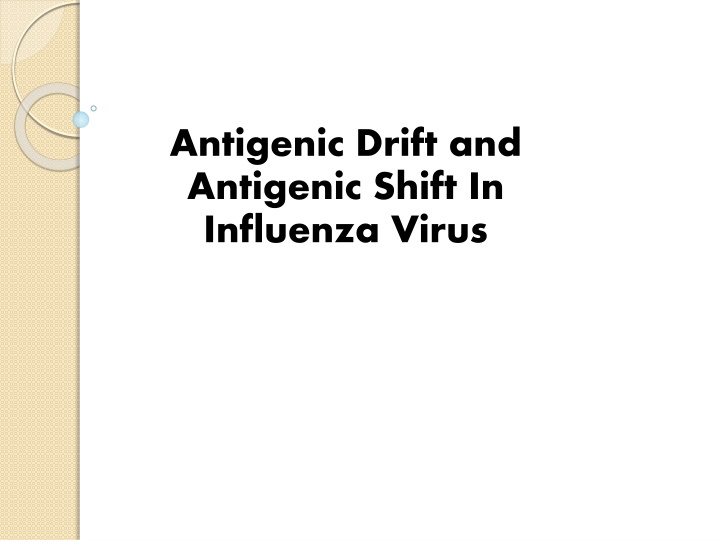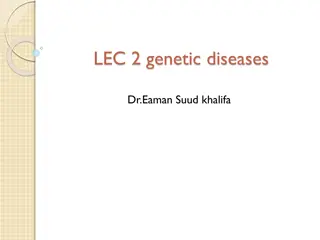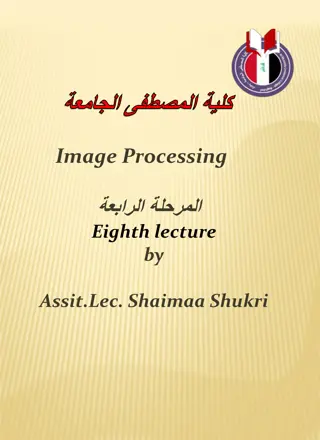
Understanding Antigenic Drift and Shift in Influenza Virus
Explore the mechanisms of antigenic drift and shift in influenza virus, including the classification of influenza A viruses based on surface proteins, historical pandemics, and the role of surface antigens. Learn how these processes contribute to viral variation and vaccine development.
Download Presentation

Please find below an Image/Link to download the presentation.
The content on the website is provided AS IS for your information and personal use only. It may not be sold, licensed, or shared on other websites without obtaining consent from the author. If you encounter any issues during the download, it is possible that the publisher has removed the file from their server.
You are allowed to download the files provided on this website for personal or commercial use, subject to the condition that they are used lawfully. All files are the property of their respective owners.
The content on the website is provided AS IS for your information and personal use only. It may not be sold, licensed, or shared on other websites without obtaining consent from the author.
E N D
Presentation Transcript
Antigenic Drift and Antigenic Shift In Influenza Virus
Influenza family of RNAviruses Orthomyxoviridae. Influenzavirus A infects humans, other mammals, and birds, and causes all flu pandemics Influenzavirus B infects humans and seals Influenzavirus C infects humans, pigs, and dogs. Influenzavirus D infects pigs and cattle
The type A viruses are the most virulent human pathogens among the three influenza types and cause the most severe disease. Influenza A viruses are further classified, based on the viral surface proteins hemagglutinin (HA or H) and neuraminidase (NA or N). Sixteen H subtypes (or serotypes) and nine N subtypes of influenza A virus have been identified.
The in humans, ordered by the number of known human pandemic deaths, are: H1N1 caused "Spanish flu" in 1918, "Swine flu" in 2009. H2N2 caused "Asian Flu". H3N2 caused "Hong Kong Flu". H5N1 is a pandemic threat. H7N7 has unusual zoonotic potential. H1N2 is endemic in humans and pigs serotypes that have been confirmed
Antigenic drift is a mechanism for variation in viruses that involves mutations within the genes that code for antibody- binding sites. the accumulation of This result in new strain of virus particles which cannot be inhibited as effectively by the antibodies that were originally targeted against previous strains, making it easier for spread throughout a partially immune population. virus to
Surface antigens of influenza: Two types Hemagglutinin b) Neuraminidase They are glycoproteins present on viral capsid. a)
Occurs with influenzaA,B and C Small number changes(mutations). Error prone viral RNA polymerase Same subtype HA changes most prominent, but can occur in any viral gene Partially responsible for yearly vaccine changes May result in epidemic of slowly occurring
Mechanism Sites recognized on hemagglutinin and neuraminidase proteins by host immune system are under pressure. So influenza as well as other viruses have these surface protein molecules. Among them hemagglutinin important to interact with host cell and start infection. So influenza virus changes the type of hemagglutinin present on their surface and produce different sub strains of the virus. constant selective is very
Not change in complete strain but still it may change the hemagglutinin spikes on the surface. Influenza capsid is fill with hemagglutinin and neuraminidase spikes. Small mutation in hemagglutinin may change the hemagglutinin spikes. This make the protein unrecognizable to pre-existing host immunity. So antibodies will no longer be functional as a result this virus can bind with host receptor and causing infection.
Antigenic shift The process by which two or more different strains of a virus, or strain of two or more different viruses, combine to form a new subtype having a mixture of the surface antigens of the two or more original strains. Re-assortment occurs among influenza viruses, whose genomes consist of eight distinct segments of RNA. These segments act like mini-chromosomes, and each time a flu virus is assembled, it requires one copy of each segment.



![Lec [2] Health promotion](/thumb/274962/lec-2-health-promotion-powerpoint-ppt-presentation.jpg)
